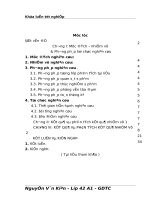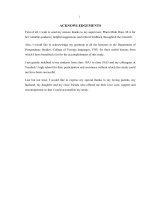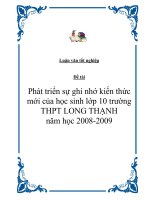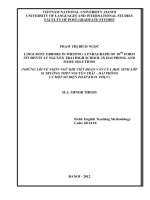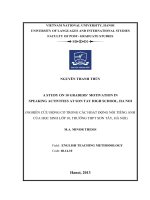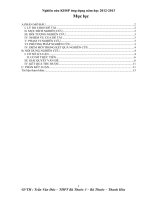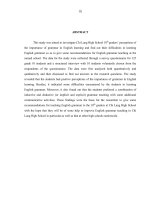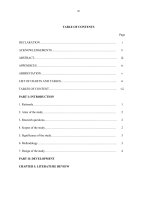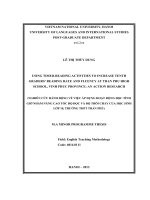attitudes towards teachers’ error correction Thái độ của học sinh lớp 10 trường THPT Nội Trú Đồ Sơn đối với việc chữa lỗi của giáo viên tro
Bạn đang xem bản rút gọn của tài liệu. Xem và tải ngay bản đầy đủ của tài liệu tại đây (1.71 MB, 62 trang )
VIETNAM NATIONAL UNIVERSITY, HANOI
UNIVERSITY OF LANGUAGES AND INTERNATIONAL STUDIES
FACULTY OF POST GRADUATE STUDIES
***
ĐỖ THỊ HỒNG HÀ
10
th
GRADE STUDENTS’ ATTITUDES TOWARDS TEACHERS’
ERROR CORRECTION IN CLASSROOM ORAL ACTIVITIES
AT DO SON BOARDING HIGH SCHOOL, HAI PHONG
THÁI ĐỘ CỦA HỌC SINH LỚP 10 TRƯỜNG THPT
NỘI TRÚ ĐỒ SƠN, HẢI PHÒNG ĐỐI VỚI VIỆC CHỮA LỖI
CỦA GIÁO VIÊN TRONG CÁC HOẠT ĐỘNG NÓI
M.A. MINOR THESIS
Field : English Teaching Methodology
Code : 601410
HANOI - 2011
VIETNAM NATIONAL UNIVERSITY, HANOI
UNIVERSITY OF LANGUAGES AND INTERNATIONAL STUDIES
FACULTY OF POST GRADUATE STUDIES
***
ĐỖ THỊ HỒNG HÀ
10
th
GRADE STUDENTS’ ATTITUDES TOWARDS TEACHERS’
ERROR CORRECTION IN CLASSROOM ORAL ACTIVITIES
AT DO SON BOARDING HIGH SCHOOL, HAI PHONG
THÁI ĐỘ CỦA HỌC SINH LỚP 10 TRƯỜNG THPT
NỘI TRÚ ĐỒ SƠN, HẢI PHÒNG ĐỐI VỚI VIỆC CHỮA LỖI
CỦA GIÁO VIÊN TRONG CÁC HOẠT ĐỘNG NÓI
M.A. MINOR THESIS
Field : English Teaching Methodology
Code : 601410
Supervisor : Khoa Anh Việt, M.A.
HANOI - 2011
iv
TABLE OF CONTENTS
PART A: INTRODUCTION 1
1. Rationale of the Study 1
2. Aims of the Study 2
3. Scope of the Study 2
4. Research Questions 2
5. Methods of the Study 3
6. Significance of the Study 3
7. Design of the Study 3
8. Summary 4
PART B: DEVELOPMENT 5
CHAPTER 1: LITERATURE REVIEW 5
1. Definition of “Error” 5
2. Types of Errors 6
3. Distinction between “Error” and “Mistake” 7
4. Perspectives on Errors and Error Correction 8
4.1. Perspectives on Errors 8
4.2. Perspectives on Error Correction 9
5. The Role of Oral Error Correction 10
6. Techniques of Oral Error Correction 12
6.1. Explicit Correction 12
6.2. Recasts 12
6.3. Prompts 13
6.3.1. Clarification Requests 13
6.3.2. Elicitation 13
6.3.3. Metalinguistic Clues. 13
6.3.4. Repetition 13
6.3.5. Finger-counting. 14
6.3.6. Facial Expression 14
6.3.7. Gestures 14
6.4. Delayed Correction 14
v
7. Previous Studies on Students’ Attitudes towards Teachers’ Oral Error Correction 15
8. Summary 17
CHAPTER 2: THE STUDY 18
II.1. Methodology 18
II.1.1. Context of the Study 18
II.1.2. Research Questions 19
II.1.3. Subjects of the Study 19
II.1.4. Data Collection Instruments 20
II.1.5. Data Collection Procedure 21
II.2. Findings and Discussion 21
II.2.1. Students’ perceptions of oral errors and oral error correction 21
II.2.2. Students’ reactions to teachers’ actual practices of oral error correction: 23
II.2.3. Students’ preferences for teacher correction of oral errors: 25
II.2.3.1. Preferred types of errors to be corrected 25
II.2.3.2. Preferred timing of error correction 27
II.2.3.3. Preferred techniques of error correction 27
II.2.3.4. Preferred forms of error correction 30
II.3. Summary 31
PART C: CONCLUSION 32
1. Summary of the Findings 32
2. Recommendations for Teachers’ Error Correction in Oral Classroom Activities 33
2.1. Knowing about the Students 33
2.2. Working out Appropriate Error Correction Strategies 34
2.3. Creating a Supportive and Pleasant Classroom Environment 36
3. Limitations of the Study 36
4. Recommendations for Further Research 36
REFERENCES 38
APPENDICES I
APPENDIX 1: SURVEY QUESTIONNAIRE I
APPENDIX 2: INTERVIEW QUESTIONS IX
APPENDIX 3: CLASSROOM OBSERVATION NOTES X
vi
LIST OF ABBREVIATIONS
CLT: Communicative Language Teaching
EFL: English as a Foreign Language
ESL: English as a Second Language
L2: Second Language
SLA: Second Language Acquisition
TESOL: Teaching of English to Speakers of Other Languages
vii
LIST OF TABLES
Table 1: Students’ perceptions on the role of oral errors in language learning
Table 2: Students’ perceptions on the role of teachers’ oral error correction
Table 3: Students’ level of understanding of teachers’ oral error correction
Table 4: Students’ level of improvement in speaking skill due to teachers’ correction
Table 5: Students’ preferences for types of errors to be corrected
Table 6: Students’ preferences for amount of error to be corrected
Table 7: Students’ preferences for timing of error correction
Table 8: Students’ preferences for error correction techniques
Table 9: Students’ most favored and least favored correction techniques
Table 10: Students’ preferences for error correction forms
1
PART A: INTRODUCTION
1. Rationale of the Study
The teaching and learning of English language is always on its progress to search
for effective methodologies. One of the issues which has constantly attracted great concern
and discussion among many linguists, educational researchers and teachers is the
correction of learners’ errors.
It has been widely accepted that error making is inevitable and it appears essential
to the language learning process. The correction of learners’ errors has also been
recognized as an integral part of language teaching. So far, a number of studies have been
conducted to seek for effective methods of correcting learners’ errors with the aim of
fostering more successful language learning. The research findings have revealed that
learners’ perceptions and attitudes towards instructional methods have a great influence on
their achievement (Schulz’s, 1996, 2001). Teachers need to know learners’ beliefs about
language teaching and learning because a mismatch between students’ expectations and the
realities they encounter in the classroom can prevent improvement in language acquisition
(Horwitz, 1988).
In reality, such mismatch has been found in many settings including Vietnam, and
as a result, it has brought about unsatisfactory learning outcomes. This problem is not an
exception in the context of Do Son Boarding High School where I have been working as a
teacher of English. From my professional experience and personal observation, I have
realized that the teachers seem not to have paid much attention to what their students think
and feel about oral error correction, whereas the students come to class with a variety of
beliefs, learning styles and language proficiency, and they respond in different ways to the
teachers’ error treatment. Rather, the teacher-centered instruction tends to be dominant and
the instructional techniques seem to follow “one size fits all” mode. These factors have
been proved to affect students’ progress in language learning in general and in speaking
English in particular.
Rooted from the problem existing in my context and the awareness of the
significance of oral error correction as well as the need for teachers to learn about their
students’ perceptions and preferences for error treatment, I would like to conduct an
investigation into “10
th
grade students’ attitudes towards teachers’ error correction in
2
classroom oral activities at Do Son Boarding High School, Hai Phong”. The fact that there
has been limited research into this subject matter in the context of Vietnam has also
inspired me to carry out this study. It is hoped that the research outcomes will be able to
assist teachers to gain more insights into the issues of oral error correction so that they can
adjust or adopt appropriate methods catering for students’ needs with the aim of improving
language learning.
2. Aims of the Study
The specific aims of the study are:
• to find out what students think about the correction of oral errors delivered by their
teachers such as whether they like their errors to be corrected, and how important they
think teachers’ error correction to their learning of English.
• to understand how students respond to the current methods of correcting oral errors
employed by their teachers, for example, to what extent they understand their teachers’
correction, and how effective they think their teachers’ instruction is.
• to explore in what ways students expect their oral error correction to be delivered (e.g.
which errors to correct, when to correct, how to correct) with the aim of matching teachers’
instruction and students’ expectations so that teachers can make best use of their methods
to enhance language learning.
3. Scope of the Study
It is clear that oral error correction is a broad issue. A study on students’ attitudes
towards oral error correction apparently opens for a variety of subject matters which
cannot be entirely discussed within the scope of a minor thesis. Therefore, in this study, I
would like to restrict the focus to investigating the attitudes towards teachers’ methods of
spoken error correction among a group of 10
th
grade students at Do Son Boarding High
School in Hai Phong city.
4. Research Questions
In an attempt to achieve the aims stated above, the present study aims to address
three research questions:
1. What are the students’ perceptions of the role of oral errors and teachers’ oral error
correction?
3
2. What are the students’ reactions to the current practices of teachers’ oral error
correction?
3. What are the students’ preferences for teachers’ correction of oral errors?
5. Methods of the Study
In order to seek for answers to the research questions, various sources of data were
used from a survey questionnaire, classroom observations and interviews.
The main instrument for collecting data is a survey questionnaire aimed to discover
what the students think about the role of errors and error correction, how they evaluate the
current practices of teachers’ error correction, and how they prefer their errors to be
corrected in classroom oral activities.
The study also included classroom observations to investigate how error correction
was delivered in the classroom to see if there was anything not revealed or anything that
confirms comments made by the students in the questionnaire.
Semi-structured interviews with a small group of students were added to the
instruments described above to get deeper insights into students’ attitudes and expectations
for teachers’ error correction methods.
6. Significance of the Study
The issue of teacher’s oral error correction has presented certain problems for both
EFL teachers and students due to the mismatch between teachers’ actual practices and
students’ expectations. As a result, the teachers’ error treatment in classroom oral activities
has not reached adequate efficiency. This study therefore hopes to find out reasonable
answers to the research questions so that teachers can gain more awareness of the
significance of students’ beliefs and their influence on the language teaching and learning.
By comparing students’ attitudes and preferences with actual classroom practices, teachers
are hoped to find out their own appropriate ways for delivering oral error correction to
their students.
7. Design of the Study
The thesis contains three main parts as follows:
• Part A provides an introduction of the study including the rationale, the aims, the
research questions, the significance, the scope, the methods and the study organization.
4
• Part B consists of two chapters. Chapter 1 presents the theoretical background for the
thesis including definitions and classifications of error; distinction between the notions of
“error” and “mistake”; major perspectives on the role of errors and error correction in
general and of oral error correction in particular; common techniques of oral error
correction; and review of previous studies on students’ attitudes and preferences for
teachers’ oral error correction. Chapter 2 describes the methodology underlying the
research including the background information about the context and subjects of the study,
the instruments used to collect the data, the procedure of data collection, and detailed
description of data analysis and discussion of the study results.
• Part C presents the summary of the findings and some pedagogical suggestions for
teachers delivering error correction in classroom oral activities. The limitations of the
study and some recommendations for further research are also discussed in this part.
8. Summary
This chapter presents an overview of the study with specific reference to the
rationale, the aims, the research questions, the significance, the scope, the methods and the
study organization. The next chapter will provide the theoretical background for the study.
PART B: DEVELOPMENT
5
CHAPTER 1: LITERATURE REVIEW
This chapter is to lay the theoretical background for the thesis by reviewing
relevant authoritative studies. Initially, the term “error” is defined and categorized
followed by the distinction between the terms “error” and “mistake”. Besides, major
perspectives on the place of errors and error correction in general and of oral error
correction in particular are discussed. The following are description and illustration of
some common correction techniques. Finally, the chapter critically reviews previous
studies on students’ attitudes and preferences for teachers’ oral error correction.
1. Definition of “Error”
There have been different definitions of “error” in language learning. It is typically
defined as a deviation from a standard form of the language. Hendrickson (1978:387)
views error as “an utterance, form or structure that a particular language teacher deems
unacceptable because of its inappropriate use or its absence in reading discourse”.
According to Dulay, Burt & Krashen (1982:183), errors are seen as “the flawed side of
learner speech or writing … that deviate from some selected norm or mature language
performance”. Norish’s (1983:7) also considers error as a deviation arising “when a learner
has not learnt something and consistently “gets it wrong”.
In foreign and L2 teaching situations, however, the “deviation” aspect of the
“errors” from a given “standard” of the language presents some problem. Allwright and
Bailey (1991) explain that the target language model at which the EFL learners are aiming
may not be the native speaker norm for the teaching is mostly done by non-native speaking
teachers. Even L2 learners living in the target culture do not always adopt the model of the
target language. The global varieties of the English language also influence the conception
of correctness. As discussed by Quirk et al (1985, cited in Mishra 2005:38), the problem
“loses its gravity against the emergence of international English: in place of a single
standard many regional varieties as standards can coexist”. Allwright and Bailey (1991)
additionally states that changes in language teaching methodology also have an effect on
deciding what an error is. In the light of the communicative approach the learners’
communicative success is considered a fit criterion to decide on errors. That is, errors only
occur if they block communication. If communication is possible despite a few slips and
6
mistakes which may be viewed as errors from syntactic point of view, it will be considered
that there is no error in the expression (Mishra, 2005).
Defining error is generally a complicated matter facing linguists, researchers and
teachers. As concluded by Chaudron (1986b:69), “the determination of errors is clearly a
difficult process that depends on the immediate context of the utterance in question as well
as on an understanding of the content of the lesson, the intent of the teacher or student, and
at times, the prior learning of the students”.
2. Types of Errors
Errors have been classified in many ways basing on psycholinguistic origins,
language skills, language components and the CLT point of view.
Basing on psycholinguistic considerations, Richard and Littlewood group errors
into three types as “intralingual”, “interlingual” and “developmental”. According to
Littlewood (1984), interlingual errors occur due to the learners’ transferring of rules from
the mother tongue, whereas intralingual errors are the result of the learner’s processing of
the target language in their own terms and these occur due mainly to overgeneralization
and simplification. Developmental errors, on the other hand, are those which “illustrate the
learner attempting to build up hypotheses about the target language” (Richard, 1974:174).
However, Dulay et al (1982) observe that most developmental errors are intralingual
errors. For them developmental errors are errors similar to those made by children learning
the target language as their first language.
Categories of errors can be made in the four skill areas of the language: speaking,
writing, reading and listening.
Errors are also categorized on the basis of language components such as
phonological, syntactic, morphological, semantic, lexical and stylistic errors.
Under the CLT point of view which considers errors as those which block
communication, Burt and Kiparsky (1972) distinguish between “global” and “local" errors.
Global errors are those that affect overall sentence organization and significantly hinder
communication. Local errors are those that affect single elements in a sentence but do not
usually hinder communication significantly.
The complexification of errors in the language classroom is necessary for
understanding the diverse universe of error possibilities in any given language context. In
7
other words, to compare error correction types without consideration of error feature
differences may completely distort the reality of how error correction functions in
classroom contexts.
3. Distinction between “Error” and “Mistake”
There are ways for teachers to distinguish between the terms “error” and “mistake”
in spite of the fact that it is quite difficult to signify a clear differentiation.
According to Corder (1967, cited in Richards 1974: 24-25), the term “error” refers
to the error of competence which is due to the learner’s defective knowledge of the target
language. He uses the term “mistake” to indicate the error of performance which is a result
of “memory lapses, physical states such as tiredness and psychological conditions such as
strong emotion”. The errors of competence are considered systematic while the errors of
performance unsystematic. Corder asserts that mistakes are not important to the language
learning process and they can be self-corrected by the learners with almost absolute
assurance. Whereas, errors are hardly amended by the learners themselves and it is
therefore necessary for the teacher to help the learners reconstruct their incomplete
knowledge of the language.
Edge (1989) and Ellis (1997) make a somewhat similar distinction between errors
and mistakes: if a learner is able to correct his own utterance, then he has made a mistake;
if he cannot correct it in his own English but the teacher thinks that the class is familiar
with the correct form, he has made an error. Brown (2000) also adopts the term “mistake”
to refer to a performance error made by language learners while producing a known
structure incorrectly through a slip of tongue or an unsystematic guess. Mistakes due to
such performance lapses do not mean incompetence but some sort of flaw in the process of
producing speech and thus they can be self-corrected.
Mistakes should be carefully distinguished from errors of a second language
learner. Nevertheless, it may not always be an easy task indeed. As stated by Brown
(2000), an error can be self-corrected if the deviation is pointed out to the speaker. It is
neutrally observed only when learners have the competence to correct the errors. However,
when there is no self-correction, mistakes or errors cannot be identified.
4. Perspectives on Errors and Error Correction
8
There are basically two different viewpoints on learners’ errors in the fields of
second and foreign language learning. On the one hand, errors are considered undesirable
and a sign of failure either on the learner’s or the teacher’s part and therefore to be
avoided. On the other hand, making errors is regarded as an integral and essential part of
the learning process. Along with the stream of these different schools of thoughts, the
correction of errors is also viewed differently. Some believe that error correction can be
effective and beneficial to language learning. The others, however, cast doubts on the role
of error correction: whether it helps language learners improve their learning. In this
section, a presentation of major views on errors and error correction from the perspectives
of pedagogy and L2 acquisition theories will be made.
4.1. Perspectives on Errors
In many traditional language classes errors are regarded negatively and have to be
eradicated. They are considered to cause loss of respect for both teachers and learners and
making too many errors is severely disapproved (Norrish, 1983). The errors are believed
to be the fault of the learners and could be prevented. This probably leads to anxiety and
hesitancy among learners to say anything for fear of making mistakes and being thought as
foolish by other learners or by the teacher.
Contrary to the traditional outlook on errors as discussed above, a great deal of
recent research in the field of first and second language acquisition regards errors as
positive aids to learning. In a language classroom, the error made by learners is considered
not evidence of failure to learn but an essential and integral part of learning a language
(Norish, 1983; Davis & Pearse, 2000; Dulay & Burt, 1974, cited in Zhu, 2010). Generally,
errors are believed to be unavoidable yet indicator of the progress in language learning.
Making errors indicates that learners are actively participating in the language learning
process (Islam, 2007). An error, according to Yule (1997, cited in Islam, 2007:7), “is not
something which hinders a learner’s progress, but is probably a clue to the active learning
progress behind made by a learner as he or she tries out ways of communicating in the new
language”. Also, errors indicate learners’ stage which reflects parts of the lesson that have
been understood and to be improved (Hedge, 2000). As stated by Corder (1981 cited in
Richards 1974), a learner’s errors are significant in three different ways. Firstly, they show
the teacher whether he undertakes a systematic analysis, how far the learner has progressed
9
and reached the goal and, accordingly, what remains for him to learn. Secondly, they
provide the researchers with evidence of how language is learnt and acquired, what
strategies or methods the learner is employing in his discovery of the language. Thirdly,
they are essential to the learner himself since error making is regarded as an instrument the
learner uses to learn the language and to test his hypotheses about the nature of the
language he is learning.
There has been a change in the attitude to errors from strictly negative to more
reasonably positive. Errors are no longer viewed as having damaging effect on the
students’ interest to learn the language but an integral part of their learning process. This
positive and tolerant attitude towards errors has also affected the perspectives on the
correction of errors which will be discussed in the following section.
4.2. Perspectives on Error Correction
Attitudes towards the correction of learners’ errors have also been a source of
debate among many foreign and second language scholars, researchers and teachers.
The debate of error correction has emerged from calls for correction of learners’
errors at all cost. Brooks (1960:56) state that “like sin, error is to be avoided … the
principal way of overcoming it is to shorten the time lapse between the incorrect response
and a presentation once more of the correct model”. Additionally, as stated by Corder
(1967, cited in Richards 1974:20), “if we were to achieve a perfect teaching method the
errors would never be committed in the first place, and that therefore the occurrence of
errors is merely a sign of the present inadequacy of our teaching techniques”. Therefore,
teachers strive to prevent their students from making errors by immediate correction which
they believe would help students be aware of their errors and not repeat them. Some
researchers are more concerned with teacher correcting learners’ errors in order to prevent
fossilization. In their viewpoints, errors have to be dealt with or otherwise can fossilize and
teacher correction is the way to save learners from fossilization (Han, 2004).
The emphasis put on an absolute capability to eradicate errors has encountered a
number of opposing ideas. The strongest argument was made by Krashen (1982) who
claims that error correction has no use and may even have a harmful effect on language
development. He explains that anxiety associated with error correction can raise a learner’s
affective filter, which impedes fluency in the L2. In sharing this view, Terrel (1977) points
10
out that affective rather than cognitive factors are of primary concern in the language
classroom, and the correction of learners’ errors is negative in terms of motivation,
attitudes, and embarrassment. Generally, error corrections are considered “a serious
mistake” that can do more harm than good because they affect learners in a negative way
and they could result in learners avoiding difficult constructions for fear of making
mistakes and trying to focus more on form than on content (Krashen, 1982). The
recommendation in this perspective is that all error correction be eliminated because it is
unnecessary, ineffective and even counterproductive.
Among the debates for and against error correction in the extreme is a preference
for selective correction of errors. In this perspective, error correction can be effective and
quite beneficial to language learning provided that it is done in an appropriate manner.
Nunan (1989) asserts that one of the functions of the teachers in the classroom is to correct
learners’ errors. However, it is essential to note that correcting all the errors that learners
make is impossible. When they are overcorrected they may become discouraged and
confused, which would probably put an end to communication. Ur (1996) also affirms that
a teacher trying to correct all mistakes might also end up with learners feeling discouraged
and depressed and this will take the interest away from learning. Additionally, as a result
of Hendrickson’s (1978) research, learners do not like to be corrected for each minor error
they made because this practice destroys their confidence to use the target language. The
teacher must therefore be sensitive and not correct the learner too much, as this can take
the attention away from aspects of content and distract more than help.
The correction of errors is apparently a complicated issue which has been open to a
great deal of discussion. Despite its controversy, there appears to be a growing consensus
among the majority of researchers and language practitioners that error correction plays an
important role in the process of second and foreign language acquisition. The debate has
shifted to the question of how to make best use of error correction for the sake of more
beneficial learning.
5. The Role of Oral Error Correction
When it comes to error correction it specifies correcting both oral and written
errors. This study, however, is particularly concerned with the correction of oral errors.
11
Oral errors, as described in Lennon’s (1991:72) “occur where the speaking fails to
follow the pattern or manner of speech of educated people in English speaking countries”.
Over the past few decades, the correction of oral errors in second and foreign language
learning has been explored in many studies. Since Chaudron’s (1977) influential
descriptive research on oral error correction, investigations into corrective feedback have
played an important role in both theory-construction and pedagogy. More recently, Lyster
and Ranta’s (1997) study of oral error correction in the context of immersion classrooms
has strongly influenced later developments of the matter. It has provided the basis for more
comprehensive and systematic research into oral error correction in SLA and increased
great interest in the application of different types of error correction in language teaching.
The role of oral error correction has become a controversial issue among many
linguists, researchers and language practitioners. Some researchers imply that teachers
should not correct students’ spoken errors. Truscott (1999), for example, provides an in-
depth investigation against delivering oral error correction on grammar. He mentions some
obstacles facing teachers and learners in giving and receiving effective oral error
correction, including the ability to identify the error without ambiguity, to evaluate the
intended meaning correctly, and to deal with the error within the context in an appropriate
way. The supporters of this debate include Allwright (1975), Fanselow (1977), and
Hendrickson (1978). However, Lyster, Lightbown, and Spada’s (1999) disapprove of
Truscott’s argument. They claim strong support for the provision of oral error correction
and consistently report a desire for it. A number of recent studies have also demonstrated
the positive effect of oral error correction. They have shown that the correction of oral
errors can contribute to L2 language acquisition. (Sheen, 2010).
Oral error correction in ESL and EFL classrooms is regarded as an instrument for
teachers to immediately help students correct their errors so as to prevent fossilization,
“the process by which non-target forms become fixed” (Ellis, 1997:353), and to achieve
better results. The effectiveness of that instrument, however, depends on the approaches to
language teaching. Traditionally, errors have been considered negative, yet this view has
changed since a communicative approach was adopted. The shift has been from a form-
focused teaching approach, which puts more emphasis on correctness regarding
pronunciation and grammar, to meaning-focused approach, which pays more attention to
vocabulary and meaning and tolerates more mistakes and errors. Both approaches are
